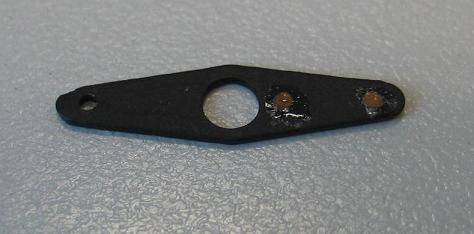Second World War Escape and Evasion compasses
Continuing from the blog about Escape & Evasion maps issued during the Second World War, escape compasses were the next important piece of equipment to be developed by MI9. These compasses were produced in a vast variety and were issued as part of escape kits, hidden in uniforms, in buttons or inside innocent looking everyday items. Below are examples of the main types of escape compasses issued during the Second World War.
Swinger compass
This basic and easy to conceal type of compass came in pairs wrapped in paper. They were small magnetised strips of diamond-shaped steel sheet with 3 small holes, two at one end which were filled with luminous radium paint, enclosed with a spot of varnish on either side (indicating North), with another small hole at the other end. Sometimes the compass would have an ‘N’ to indicate North. It had a larger hole at the centre through which you would tie a piece of string to suspend the compass.

Early miniature escape rotor compass
1/2 inch (1.2cm) rotor compass. The rotating bezel could have a variety of finishes. The bezel has four holes and North is marked with a dotted line. Made c 1940-1942.
Later miniature escape rotor compass
The bezel was replaced by a star shaped pointer. North is marked by luminous radium paint dots and a red triangle. Made c 1943-1945.
Rotor compass in plastic pouch
Small rotor compasses were sealed in clear plastic pouches, or’ bubbles’ (now often discoloured) to protect them from humidity in the tropics. The compasses in the small round ‘bubbles’ were usually contained in escape and evasion kits. Others were placed in larger pouches which had cotton tape threaded through the top so the compass could be worn around the neck during operations.
Rotor compass concealed in RAAF buttons
The back of the button unscrews to reveal a small rotor compass. The British / Commonwealth buttons screwed off to reveal the compass. The American buttons had a hinged opening.
The stud has a flat white painted glass face that could be scratched away to reveal the compass.
Bakelite button compass
Sometimes called a “Weskit” escape compass button, it has luminous radium paint dots on the reverse, two at one end indicating North, and one at the other indicating South. They were made in black (Air Force) and brown (Army). The magnet was moulded inside the Bakelite. When in use, the compass would be suspended by a piece of thread through the lug. Holding the Bakelite compass in water helped stop the compass swinging.
Fly button compass
Pair of brass fly buttons. One button has a small spike in the centre and the other has a small indent for sitting on top. The upper button has small luminous radium paint dots to indicate north and south.
Belt buckle with concealed compass
Chrome-plated Royal Air Force belt buckle with sliding teeth to secure a fabric belt on a battlefield blouse. On the central bar a sliding bracket secures a compass needle with luminous radium paint dots. When removed this sits on a small spike on the other side of the buckle, which when not in use folds down along the bar.
Ad hoc compasses
In addition to specifically manufactured compasses, MI9 also magnetised a variety of everyday metal items to act as compasses by pointing north. The shoe laces of 1943 Pattern escape boots were magnetised, as were razor blades, pencil clips, needles, pen nibs, hacksaws and just about any other small metallic items they could find.
FURTHER READING:
- Per Ardua Libertas (catalogue of a selection of items made by MI9, published c 1942 for their American counterparts)
- Official Secret / Clayton Hutton
- MI9 Escape & Evasion 1939-1945 / MRD Foot & JM Langley
- Luftwaffe vs. RAF : flying equipment of the air war 1939-45 / Mick J, Prodger
- Behind Enemy Lines: evasion and escape aids of World war II (exhibition catalogue from the Frazier History Museum, Louisville, Kentucky 2013) / R E Baldwin
- The Escape Factory: The Story of MIS-X, the Super-Secret U.S. Agency Behind World War II’s Greatest Escapes, St. Martin’s Press / Lloyd Shoemaker








